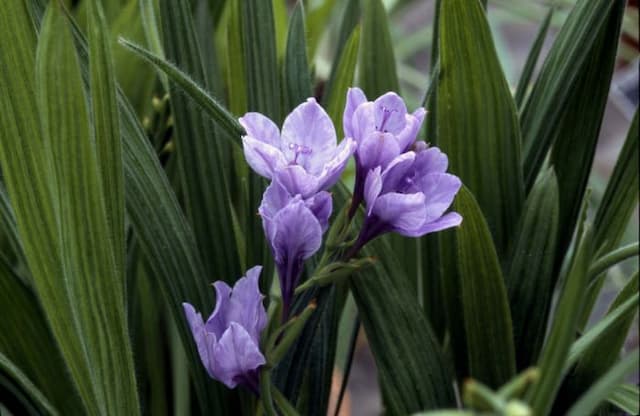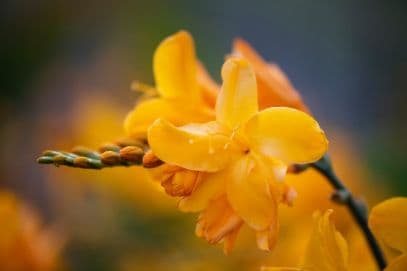Intermediate Bearded Iris Iris 'Innocent Heart' (IB)

ABOUT
Iris 'Innocent Heart' is an elegant perennial plant known for its striking flower appearance. It showcases blooms of soft colors, typically shades of lavender, lilac, or pale violet, which are beautifully contrasted by streaks or patches of deeper tones or white. The petals have a plush, velvety texture and are arranged in a classic iris form with three upright "standards" and three drooping "falls," creating a delicate, ruffled look. The falls often display a splash of color or a beard—a fuzzy line that runs down the middle of the petal. The foliage of this iris consists of long, slender, sword-like leaves that have a bright green hue and grow in a dense clump. They create a tufted, grassy backdrop which complements the showy blooms. The Iris 'Innocent Heart' blooms in the spring to early summer, offering a captivating display of color and form in the garden.
About this plant
 Names
NamesFamily
Iridaceae
Synonyms
Intermediate Bearded Iris, IB Iris
Common names
Iris 'Innocent Heart' (IB)
 Toxicity
ToxicityTo humans
The Iris 'Innocent Heart' is generally considered to have parts that can be toxic when ingested by humans. The most common common name for this plant is simply Iris. The various parts of the Iris, including rhizomes, leaves, and flowers, contain compounds such as irisin, iridin, or irisine which can cause digestive upset if ingested. Symptoms of poisoning can include nausea, abdominal pain, vomiting, and diarrhea. In severe cases, there might also be secondary symptoms like dehydration or an electrolyte imbalance due to excessive vomiting and diarrhea. It is advised that humans should be cautious and not consume any parts of Iris plants.
To pets
The Iris 'Innocent Heart', commonly known as Iris, can be toxic to pets if ingested. The plant contains irisin, iridin, and other potentially harmful compounds that are concentrated in the rhizomes but can also be present in leaves and flowers. If a pet ingests part of an Iris plant, symptoms of toxicity may include gastrointestinal upset such as vomiting and diarrhea, drooling, lethargy, and in severe cases, increased heart rate and breathing difficulties. It is recommended to keep Iris plants out of reach of pets and to seek veterinary care if you suspect your pet has ingested any part of an Iris plant.
 Characteristics
CharacteristicsLife cycle
Perennials
Foliage type
Deciduous
Color of leaves
Green
Flower color
Mixed
Height
2 feet [60 cm]
Spread
1 foot [30 cm]
Plant type
Bulb
Hardiness zones
4
Native area
Cultivar
Benefits
 General Benefits
General Benefits- Ornamental Appeal: The Iris 'Innocent Heart' adds aesthetic value to gardens with its showy blooms and attractive foliage.
- Easy to Grow: This plant is generally easy to care for, making it suitable for gardeners of all skill levels.
- Drought Tolerance: Once established, it can tolerate periods of dryness, reducing the need for frequent watering.
- Seasonal Interest: It can provide seasonal interest in the garden, especially during its blooming period in spring.
- Wildlife Attraction: The flowers can attract pollinators such as bees and butterflies, supporting local ecosystems.
- Soil Adaptation: Iris 'Innocent Heart' can adapt to a variety of soil conditions, though it prefers well-drained soils.
- Multiplication: It can be easily divided to produce new plants, making it cost-effective for garden expansion.
 Medical Properties
Medical PropertiesThis plant is not used for medical purposes.
 Air-purifying Qualities
Air-purifying QualitiesThis plant is not specifically known for air purifying qualities.
 Other Uses
Other Uses- Dye Source: The flowers of the bearded iris can be used to create natural dyes for fabrics, giving pale yellow to greenish-yellow hues depending on the mordant used.
- Artistic Inspiration: Artists often use the intricate patterns and colors of bearded iris flowers as inspiration for paintings, drawings, and textile designs.
- Culinary Decoration: The petals of bearded iris can be used as an elegant garnish for salads and desserts, provided they haven't been treated with pesticides or chemicals.
- Photography Subject: The bearded iris's distinctive shape and vibrant colors make it a favorite subject for photographers, especially in macro photography.
- Floral Arrangements: Bearded iris blooms are commonly used in floral arrangements for events and special occasions, thanks to their striking appearance.
- Eco-friendly Confetti: Dried petals of the bearded iris can serve as a biodegradable confetti alternative at celebrations, reducing environmental impact.
- Symbolic Gift: Representing wisdom, hope, and trust, bearded iris plants or flowers can be given as gifts to convey deep messages without words.
- Garden Design: The bearded iris is often used in xeriscaping and water-conservative garden designs due to its drought tolerance when established.
- Perfumery: Although not as common as other flowers, the bearded iris can be used in the production of perfumes for its light, delicate scent.
- Education: Botany and horticulture classes use the bearded iris to teach students about plant biology, hybridization, and the importance of pollinators.
Interesting Facts
 Feng Shui
Feng ShuiIris is not used in Feng Shui practice.
 Zodiac Sign Compitability
Zodiac Sign CompitabilityIris is not used in astrology practice.
 Plant Symbolism
Plant Symbolism- Hope: The Iris symbolizes hope, signifying expectation and belief in positive outcomes for the future.
- Wisdom: Often associated with wisdom, irises reflect intelligence and valued knowledge.
- Courage: The strong and upright stance of an iris is emblematic of courage, inspiring bold actions and bravery.
- Faith: Irises can express faith, illustrating trust and devoutness in various aspects of life or spirituality.
- Royalty: With its regal appearance, the iris is often connected to royalty and majesty, implying noble disposition and luxury.
- Purity: The delicate and pure color of 'Innocent Heart' suggests innocence and cleanliness, often used in contexts requiring unblemished character.
 Water
WaterIntermediate Bearded Iris, commonly known as Iris 'Innocent Heart,' requires even moisture during the growing season, especially before and during bloom. Water the plant deeply once a week, providing about one inch of water each time to ensure the soil remains moist but not waterlogged. During hotter, drier periods, increase the frequency to twice a week. After blooming, reduce watering to encourage the plant to go dormant in preparation for winter. In fall and winter, watering can generally be minimized to prevent rot, totaling approximately half a gallon per month if there is no significant rainfall.
 Light
LightIntermediate Bearded Iris thrives in full sun, which means it requires at least 6 hours of direct sunlight each day. The ideal location for Iris 'Innocent Heart' is a spot where it can receive uninterrupted sunlight throughout the day, but some light afternoon shade can be beneficial in extremely hot climates to prevent foliage burn.
 Temperature
TemperatureIntermediate Bearded Iris prefers moderate temperatures and can generally tolerate a range from 30°F to 90°F. The ideal temperature for Iris 'Innocent Heart' is between 55°F and 75°F. It's important to ensure the rhizomes are well-mulched in winter to protect against freezing temperatures below 30°F, as extended periods of extreme cold can damage the plant.
 Pruning
PruningIntermediate Bearded Iris should be pruned to remove spent blooms and dead foliage to encourage healthy growth and prevent disease. Pruning is best done right after the plant has finished flowering by cutting the flower stalks down to the base of the plant. Additionally, in late summer or early fall, trim away any damaged or diseased leaves. Pruning yearly promotes better airflow among the leaves and reduces the risk of bacterial and fungal infections.
 Cleaning
CleaningAs needed
 Soil
SoilThe best soil mix for an Intermediate Bearded Iris like 'Innocent Heart' should be well-draining and slightly acidic to neutral in pH, generally between 6.0 to 7.0. A mixture of loamy garden soil, compost, and sharp sand would support healthy growth. The soil should also be rich in organic matter to promote robust blooms.
 Repotting
RepottingIntermediate Bearded Irises such as 'Innocent Heart' typically don't require frequent repotting and can thrive in the same location for several years. However, it is recommended to divide and repot them every 3-5 years to prevent overcrowding and ensure the health of the clumps.
 Humidity & Misting
Humidity & MistingIntermediate Bearded Irises, like 'Innocent Heart', are not overly sensitive to humidity levels but thrive best in moderate humidity conditions that mimic their natural outdoor environment; excessively high humidity can encourage disease.
 Suitable locations
Suitable locationsIndoor
Ensure plenty of light and good air circulation.
Outdoor
Full sun, well-drained soil, space clumps for air flow.
Hardiness zone
3-9 USDA.
 Life cycle
Life cycleThe Iris 'Innocent Heart' (IB), also known as a type of Intermediate Bearded Iris, starts its life cycle as a seed that germinates in suitable soil conditions with sufficient moisture. Upon germination, it develops a small rhizome, which acts as the plant's storage organ, and initiates the growth of roots and foliage. The plant grows leaves that are sword-shaped and starts to form a fan-like structure. As it matures, usually in the second or third year, the rhizome produces a flowering stalk during late spring to early summer, which bears the distinct and ornamental flowers typical of irises. After blooming, the plant enters a period of vegetative growth and energy storage in the rhizome, allowing it to survive during winter dormancy. The iris can then propagate itself by producing offsets from the mother rhizome, or it can be divided by gardeners for propagation, continuing its life cycle.
 Propogation
PropogationPropogation time
Late summer
The Iris 'Innocent Heart', a type of Intermediate Bearded Iris, is commonly propagated by division, a process that encourages the growth of new individual plants from the splitting of the mother plant. The best time for this is late summer to early fall, after the flowering has concluded, when the plant is not actively growing. To propagate by division, you would carefully dig up the rhizomes, which are the horizontal stems growing underground, and gently brush off the excess dirt. Using a sharp knife, sections of the rhizome should be cut into pieces, each with at least one leaf fan and healthy roots. These sections are then replanted in well-draining soil, with the top of the rhizome slightly exposed to the air. This method ensures healthy clones of the parent plant, allowing the gardener to expand their Iris 'Innocent Heart' collection or share with others.









